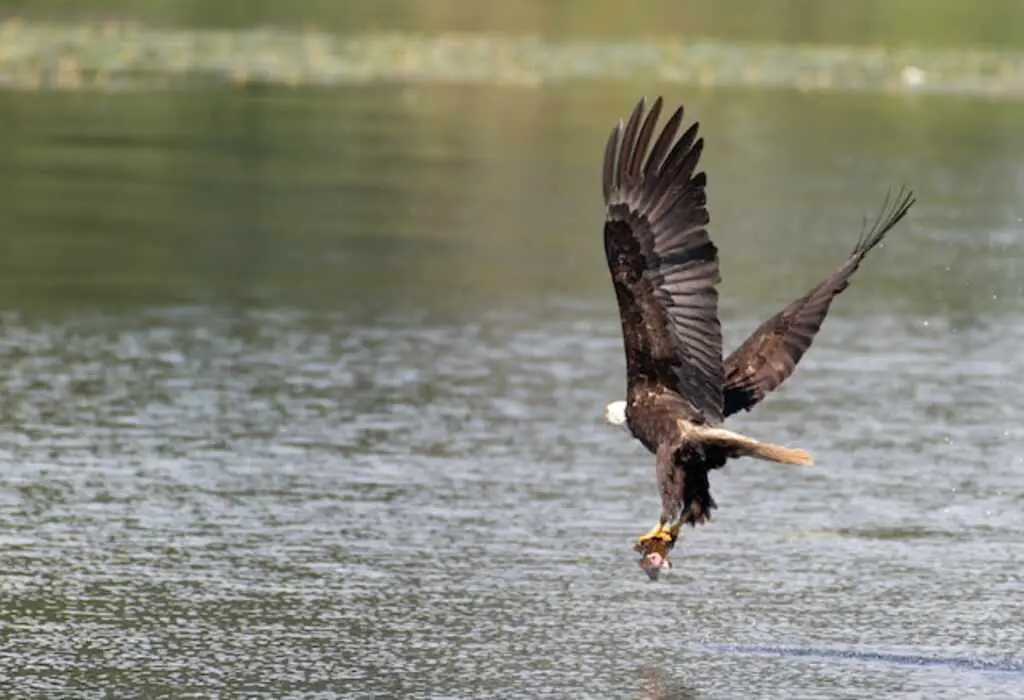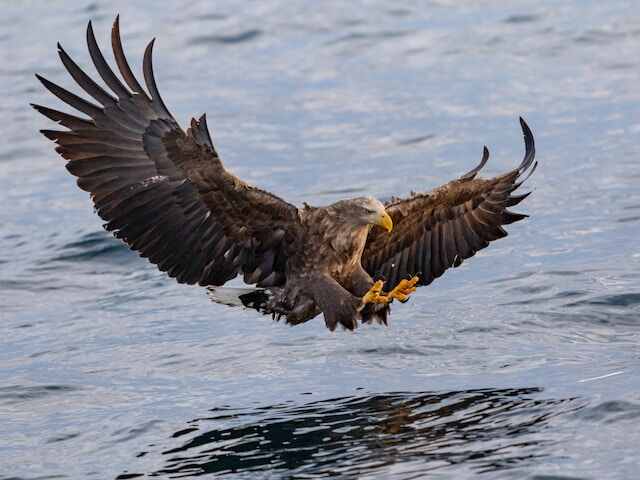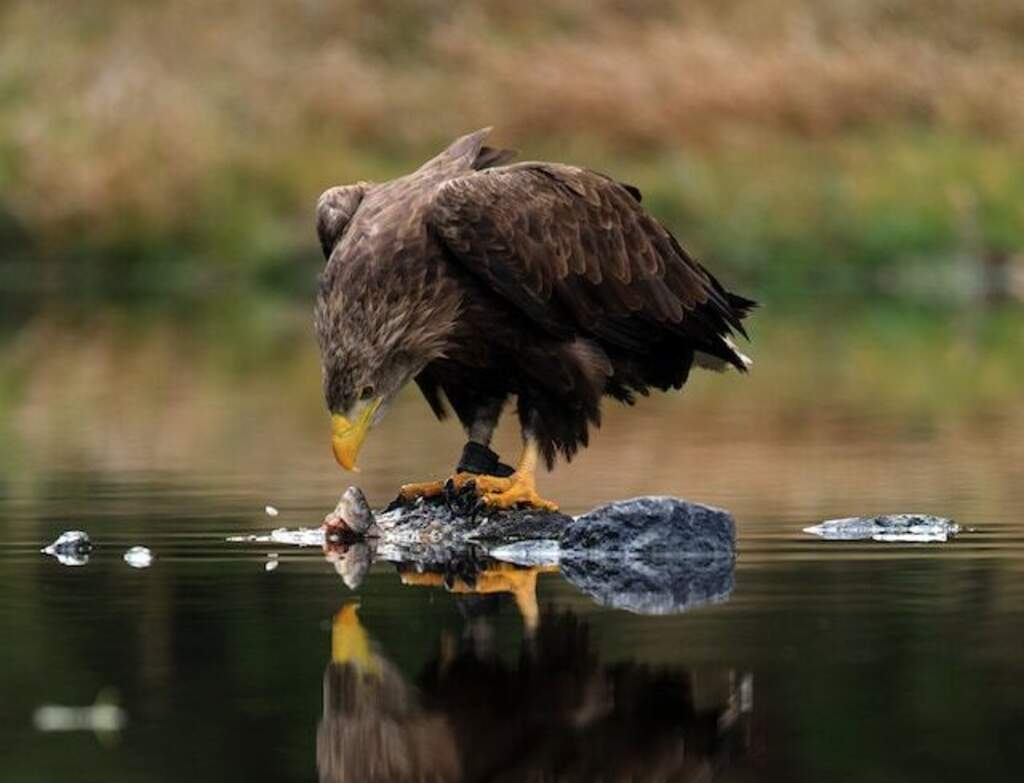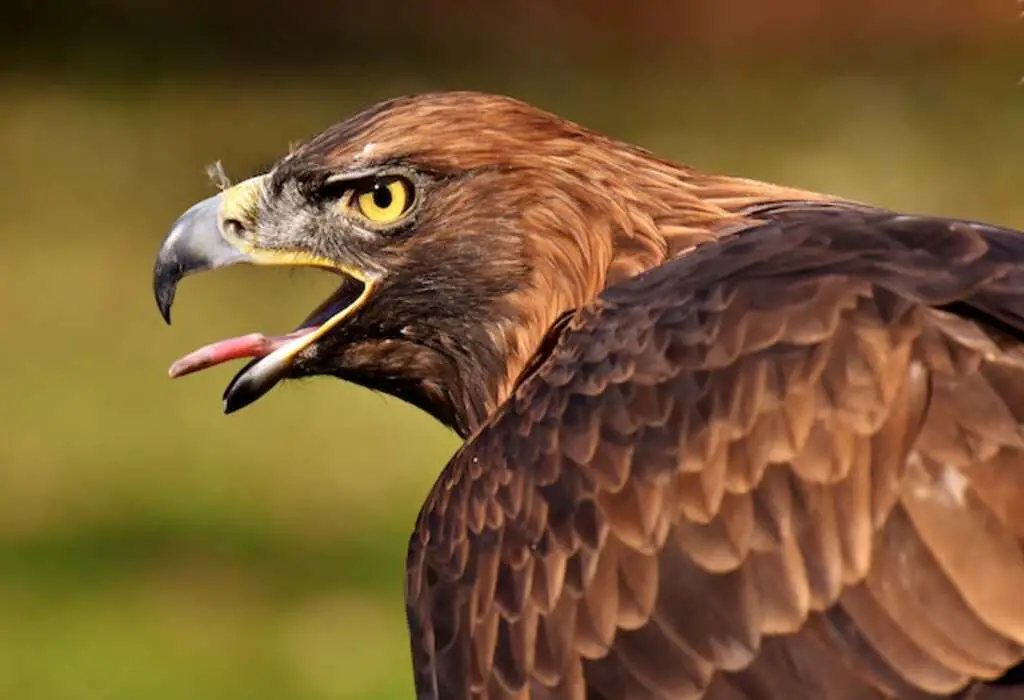What do eagles eat? Prepare to be captivated by the remarkable dining habits of these majestic birds of prey.
From their preference for fish to their surprising inclusion of small mammals and invertebrates, eagles are the ultimate gastronomic adventurers.
Join us on a journey to uncover the intricate web of their dietary preferences and adaptations, exploring seasonal variations and the impact of human interactions.
Get ready to soar into a comprehensive overview of eagle diets and discover the fascinating relationships they have with their ecosystems.
Table of Contents
- 1 Key Takeaways
- 2 Introduction to Eagle Diets
- 3 What Do Eagles Eat
- 4 General Overview of Eagle Diets
- 5 Prey Preferences and Adaptations
- 6 Fish as a Primary Food Source
- 7 Small Mammals in Eagle Diets
- 8 Birds as Prey for Eagles
- 9 Reptiles and Amphibians as Prey
- 10 Scavenging and Carrion Consumption
- 11 Interactions with Invertebrates
- 12 Seasonal Variations in Eagle Diets
- 13 Human Interaction and Dietary Impacts
- 14 Conclusion
- 15 Frequently Asked Questions
- 16 Conclusion
- 17 Further Reading
- 18 Author
Key Takeaways
- Eagles have a diverse diet consisting mainly of fish, small mammals, birds, carrion, reptiles, amphibians, insects, and arthropods.
- Aquatic habitats, wetlands, and forests play a crucial role in providing food sources for eagles.
- Invasive species and human activities like land development and pollution can impact eagle diets and their prey availability.
- Eagle predation has complex ecological dynamics and can influence population dynamics of various bird species, reptiles, and amphibians.

Introduction to Eagle Diets
Understanding the feeding habits of eagles is crucial in gaining insights into their ecological role and behavior.
By studying eagle diets, researchers can determine the species and quantity of prey consumed.
This information can provide valuable information about the community dynamics and trophic interactions within their habitats.
This knowledge is essential for conservation efforts and managing the populations of both eagles and their prey species.
Understanding the Feeding Habits of Eagles
Eagles’ feeding habits revolve around their ability to spot and seize prey with their sharp, curved beaks and powerful talons.
To understand their feeding habits, it is important to consider their prey selection, hunting techniques, and ecological impact.
Eagles primarily feed on fish, small mammals, birds, and carrion. They use a variety of hunting techniques such as soaring, perching, and stooping.
Studying eagle diets is significant as it provides insights into the health of ecosystems and helps in conservation efforts.
Significance of Studying Eagle Diets
Studying the diets of eagles provides valuable insights into the intricate connections and interdependencies within ecosystems, shedding light on the delicate balance of nature and aiding in the formulation of effective conservation strategies.
Eagles, as apex predators, play a crucial role in maintaining ecological balance through trophic cascades.
By understanding their feeding habits, we can better comprehend the impact they have on their prey populations and the overall health of the ecosystem.
This knowledge will be further explored in the subsequent section, which provides a general overview of eagle diets.
What Do Eagles Eat
Eagles primarily eat fish, but their diet extends beyond aquatic delicacies. These majestic birds of prey also consume small mammals, birds, carrion, reptiles, amphibians, insects, and arthropods. Their diverse menu showcases their adaptability as top predators in maintaining ecological balance.
General Overview of Eagle Diets
The classification of eagles as carnivorous birds is based on their feeding habits, which primarily consist of consuming meat.
This diet is crucial for eagles as meat provides them with essential nutrients and energy needed for their survival and reproduction.
Their ability to hunt and consume meat allows eagles to maintain their predatory lifestyle and thrive in their natural habitats.
Classification of Eagles as Carnivorous Birds
Categorizing eagles as carnivorous birds sheds light on their dietary preferences and hunting strategies.
Eagles have evolved prey adaptations that make them efficient hunters. They have sharp, hooked beaks and powerful talons for capturing and killing their prey.
Eagles also exhibit a wide range of prey selection, feeding on fish, mammals, birds, and even reptiles.
Their feeding behaviors vary depending on the type of prey, with some eagles swooping down from the sky to catch their prey, while others engage in aerial pursuits.
Understanding the importance of meat in eagle diets further emphasizes the significance of their carnivorous nature.
Importance of Meat in Eagle Diets
Meat plays a crucial role in the dietary composition of eagles, highlighting their adaptation as carnivorous birds. Eagles rely on meat as a primary source of nutrition due to their specific nutritional requirements.
This high-protein diet is necessary for their growth, reproduction, and overall survival. To capture their prey, eagles employ various hunting techniques such as aerial dives and ambush strategies.
These strategies allow them to target a wide range of prey species, ensuring prey diversity in their diets.
With such reliance on meat, eagles have developed specific prey preferences and adaptations for successful hunting and consumption, which will be discussed in the subsequent section.

Prey Preferences and Adaptations
This paragraph will discuss the common prey items for eagles, the factors influencing their prey selection, and their unique adaptations for hunting and feeding.
Eagles commonly prey on small to medium-sized mammals, birds, and fish.
Factors that influence their prey selection include availability, abundance, and ease of capture.
Eagles have unique adaptations for hunting and feeding, such as sharp talons for grasping and piercing, strong beaks for tearing flesh, and keen eyesight for locating prey from a distance.
Common Prey Items for Eagles
Avian predators of the genus Aquila typically rely on a wide array of prey items, including small mammals, fish, and occasionally reptiles or birds. Their diet varies depending on factors such as availability and habitat.
Some common prey items for eagles include rabbits, squirrels, voles, and fish.
Understanding the diet of eagles is important for fish conservation efforts, as eagles play a crucial role in controlling fish populations.
Factors influencing prey selection will be discussed in the next section.
Factors Influencing Prey Selection
Factors such as habitat type, prey availability, and competition influence the prey selection of eagles, shaping their diet and ultimately impacting the dynamics of the ecosystems they inhabit.
Eagles exhibit prey preferences and adaptations that enable them to efficiently capture and consume their chosen prey.
Understanding these factors is crucial for conservation efforts as changes in habitat or prey availability can have significant implications for eagle populations.
These factors will be further explored in the subsequent section on unique adaptations for hunting and feeding.
Unique Adaptations for Hunting and Feeding
Unique adaptations for hunting and feeding in eagles can be observed through their specialized beaks, talons, and keen eyesight. These adaptations enable eagles to excel in capturing prey and securing their primary food source.
With their powerful beaks, eagles are capable of tearing apart flesh and extracting meat from their prey.
Their sharp talons provide a strong grip, allowing them to grasp and immobilize their prey effectively.
Additionally, their exceptional eyesight aids in prey detection and capture.
Transitioning into the subsequent section, eagles’ unique adaptations for hunting make them highly efficient at catching fish, which serves as their primary food source.

Fish as a Primary Food Source
The fishing techniques employed by fish-eating eagles are varied and specialized, allowing them to effectively capture their primary food source.
These techniques include soaring and scanning for fish from high altitudes, diving into the water to snatch fish with their talons, and even stealing fish from other birds.
Notable fish species in eagle diets include trout, salmon, and various types of small to medium-sized fish.
The role of aquatic habitats in eagle feeding is crucial, as these habitats provide the necessary environment and resources for fish populations to thrive, ensuring a steady supply of food for fish-eating eagles.
Fishing Techniques Employed by Fish-Eating Eagles
Fish-eating eagles employ a variety of fishing techniques to catch their prey. These techniques include:
- Plunge diving: The eagle dives from the air, plunging into the water to catch fish near the surface.
- Perched hunting: The eagle waits on a perch near the water and catches fish as they swim by.
- Surface skimming: The eagle flies low over the water, using its sharp talons to snatch fish from the surface.
- Stealing from other birds: Some eagles steal fish from other birds, such as ospreys or pelicans.
These fishing techniques, along with their prey preferences and unique adaptations, allow fish-eating eagles to effectively catch their food. Notable fish species in eagle diets will be discussed in the subsequent section.
Notable Fish Species in Eagle Diets
Notable species of fish commonly found in the diets of eagles evoke a sense of awe and wonder. Eagles employ various fishing techniques to capture their prey, including swooping down from the sky and snatching fish from the water’s surface with their talons.
Some of the fish species that eagles frequently feed on include trout, salmon, catfish, bass and carp.
Additionally, eagles are known to prey on small carnivores such as muskrats and small mammals that inhabit aquatic habitats.
This highlights the important role that these habitats play in eagle feeding.
Transitioning to the subsequent section, the role of aquatic habitats in eagle feeding is multifaceted and essential for their survival.
The Role of Aquatic Habitats in Eagle Feeding
Aquatic habitats play a vital role in the feeding patterns of eagles, as they provide a diverse array of prey options, with fish accounting for approximately 70% of their diet.
Wetlands, in particular, are crucial for eagle populations as they offer rich feeding grounds. Protecting these habitats is essential for the conservation of eagle populations.
Understanding the role of wetlands in eagle feeding can help develop effective conservation strategies. Next, we will explore the role of small mammals in eagle diets.
Small Mammals in Eagle Diets
Small mammals such as rodents and lagomorphs are important prey items in the diets of eagles. These small mammals provide a valuable source of nutrients for eagles, including protein and fat.
Eagles are known to prey on small carnivores and ungulates as well, further diversifying their diet and ensuring a sufficient intake of energy.
Additionally, eagles may interact with invasive species, either as prey or competitors, which can have implications for their foraging behavior and population dynamics.
Rodents and Lagomorphs as Prey
Rodents and lagomorphs comprise a significant portion of the diet of eagles. Factors influencing prey selection include the availability and abundance of these small mammals.
Eagles have unique adaptations for hunting and feeding on rodents and lagomorphs, such as sharp talons and strong beaks.
They are efficient predators, capable of capturing and consuming these prey items. In addition to small mammals, eagles also engage in predation on small carnivores and ungulates.
Predation on Small Carnivores and Ungulates
Predation on small carnivores and ungulates by eagles is facilitated by their specialized adaptations, such as sharp talons and strong beaks, which enable them to efficiently capture and consume these larger prey items.
Eagles employ various hunting techniques when targeting small carnivores, such as swooping down from above or ambushing their prey.
In the case of ungulates, eagles often target young or weak individuals. These predatory behaviors play a crucial role in the ecological dynamics of eagle populations.
Transitioning into the subsequent section on interactions with invasive species, eagles’ predation habits can also influence the success or failure of invasive species in their ecosystems.
Interactions with Invasive Species
Invasive species may face challenges in the presence of eagles due to the potential disruptions in their ecological interactions and population dynamics.
The impact of invasive species on native ecosystems can be significant, leading to the loss of native species and alteration of ecosystem processes.
To mitigate the ecological consequences of invasive species, management strategies such as removal or control programs are often implemented.
Understanding these interactions is crucial in developing effective strategies for conserving biodiversity and ecosystem function.
Transitioning to the subsequent section, eagles also prey on birds in their diet.

Birds as Prey for Eagles
Avian prey selection and hunting strategies are important factors to consider when studying the diets of eagles.
Eagles are known to have a diverse diet, and their hunting strategies vary depending on the type of bird they are targeting.
Interactions with waterfowl and shorebirds are particularly interesting, as eagles often compete with other predators for these species, leading to complex ecological dynamics.
These interactions have implications for bird conservation, as eagles can have a significant impact on the populations of their avian prey, especially if their numbers are not properly managed.
Avian Prey Selection and Hunting Strategies
Leveraging their impressive hunting strategies, eagles carefully select and capture their prey from the avian population.
Avian hunting techniques vary among eagle species, with some relying on aerial pursuits, while others employ ambush tactics.
Eagles primarily detect their prey using keen eyesight, which allows them to spot even small birds from great distances.
Their hunting success rates are high due to their speed, agility, and powerful talons.
These hunting strategies will be further explored in the subsequent section on interactions with waterfowl and shorebirds.
Interactions with Waterfowl and Shorebirds
Interactions between eagles and waterfowl and shorebirds reveal the intricate dynamics of predator-prey relationships.
Eagles, like skilled hunters, engage in strategic pursuits reminiscent of a precise ballet performance.
Eagles often target waterfowl and shorebirds as their prey, which can have significant effects on population dynamics within these bird species.
Understanding these interactions is crucial for developing effective conservation strategies to ensure the preservation of these vulnerable avian populations.
These findings have important implications for bird conservation moving forward.
Implications for Bird Conservation
The intricate dynamics of predator-prey relationships between eagles and waterfowl and shorebirds have significant implications for bird conservation efforts and the preservation of vulnerable avian populations.
Understanding the impact of eagles on bird populations is crucial for effective habitat preservation and management.
Research gaps exist in quantifying the precise effects of eagle predation on bird populations, particularly in relation to population dynamics and long-term trends.
This knowledge is essential for developing targeted conservation strategies.
Transitioning into the subsequent section, eagles also play a significant role in the predation of reptiles and amphibians.
Reptiles and Amphibians as Prey
The predation on snakes and lizards is a significant aspect of the feeding behavior of eagles.
Eagles have been observed hunting and consuming various species of snakes and lizards, using their powerful talons and beak to capture and kill their prey.
Additionally, eagles have been known to feed on turtles and tortoises, which provide a valuable source of nutrition due to their high protein content.
Furthermore, eagles also consume amphibians, such as frogs and salamanders, which offer a diverse and abundant food source in aquatic and terrestrial habitats.
Predation on Snakes and Lizards
Predators such as eagles exhibit a remarkable ability to prey upon snakes and lizards, evoking a sense of awe and admiration for their hunting prowess.
Their predation impact on snakes and lizards plays a crucial ecological role, helping to control their populations and maintain a balanced ecosystem.
However, this predation can also have conservation implications, especially when eagles target endangered or threatened species.
Transitioning to the subsequent section, eagles also show a remarkable capability in feeding on turtles and tortoises.
Feeding on Turtles and Tortoises
Remarkably, eagles possess an incredible ability to consume turtles and tortoises, which often leaves one pondering the vulnerability of these seemingly impenetrable creatures.
Eagles primarily target turtles when they emerge from their habitats to lay eggs or bask in the sun. They use their sharp talons to grip the turtle’s shell and their powerful beak to break it open.
This behavior highlights the importance of turtle conservation and protecting their habitats.
Moving forward, we will explore the consumption of amphibians by eagles.
Consumption of Amphibians
Interestingly, the consumption of amphibians by eagles sheds light on the delicate balance of ecosystems and the importance of preserving their habitats.
Eagles play a crucial role in influencing amphibian populations through their interactions with them.
Amphibians, such as frogs and salamanders, serve as a significant food source for eagles, contributing to their diet and overall ecological role.
However, the decline in amphibian populations due to habitat loss and pollution highlights the need for conservation efforts.
Moving forward to scavenging and carrion consumption, eagles also play a vital role in recycling nutrients within ecosystems.

Scavenging and Carrion Consumption
Eagles play a crucial role in scavenging as they are known to consume carrion, or dead animals, in their diet.
They exhibit scavenging behaviors by actively searching for and feeding on carcasses, often competing with other scavengers such as vultures.
Their opportunistic feeding habits enable them to take advantage of available food sources, making them highly adaptable and successful predators.
Role of Eagles in Scavenging
Furthermore, the scavenging behavior of eagles plays a significant role in maintaining the ecological balance and nutrient cycling within their respective ecosystems.
Eagles, as scavengers, contribute to the decomposition process by feeding on carrion and carcasses.
This scavenging behavior helps prevent the accumulation of dead organisms, reducing the risk of disease transmission and the release of harmful gases.
Additionally, the presence of eagles as scavengers helps regulate population sizes of other animals by consuming weak or injured individuals.
This seamless transition into the next section about scavenging behaviors and opportunistic feeding highlights the adaptive nature of eagles.
Scavenging Behaviors and Opportunistic Feeding
Scavenging behaviors and opportunistic feeding are crucial components of the ecological role played by eagles and contribute to the overall health and balance of their respective ecosystems.
Eagles have developed scavenging adaptations that allow them to efficiently locate and consume carrion. Their prey selection factors vary depending on factors such as availability and competition.
Additionally, eagles’ seasonal diet variations reflect changes in prey availability and migration patterns.
These behaviors and adaptations will be further explored in the subsequent section on interactions with invertebrates.
Interactions with Invertebrates
Insects and arthropods play a significant role in the diets of eagles. These invertebrates provide an important source of nutrition for nesting eagles, especially during the breeding season, when their energy demands are high.
Invertebrates such as beetles, ants, and spiders are rich in protein and other essential nutrients, making them a valuable food resource for eagles.
Insects and Arthropods in Eagle Diets
Predatory birds like eagles rely on a diverse range of prey, including small but vital creatures such as insects and arthropods.
Insects are a major component of eagle diets, providing a source of protein and nutrients. Eagles have adaptations such as sharp beaks and talons that enable them to capture and consume insects efficiently.
Arthropod diversity ensures a steady supply of prey for eagles. These insects and arthropods are crucial for the survival and breeding success of nesting eagles.
Importance of Invertebrates for Nesting Eagles
Insects and arthropods play a crucial role in the diets of eagles, particularly during the nesting season.
These invertebrates serve as an important food source for nesting eagles, contributing to their overall nesting success.
Maintaining healthy invertebrate populations is essential for the ecological balance of eagle habitats.
Understanding the significance of invertebrates in eagle diets enables conservation efforts to prioritize the preservation of these species.
Moving forward, we will explore the seasonal variations in eagle diets.
Seasonal Variations in Eagle Diets
Seasonal variations in eagle diets are influenced by several factors, including diet shifts based on seasonal availability, migration, and dietary changes.
During different times of the year, the availability of prey species may fluctuate, leading to changes in the composition of an eagle’s diet.
Additionally, eagles may migrate to different areas in search of more abundant food sources, which can further impact their dietary preferences.
Furthermore, eagles may also undergo dietary changes as they mature or in response to environmental factors, such as competition for resources.
Diet Shifts Based on Seasonal Availability
Availing themselves of the diverse array of food sources, eagles exhibit remarkable adaptability in their diet. They are capable of shifting their diet based on the seasonal availability of prey.
During the breeding season, eagles primarily feed on small mammals, fish, and birds. However, in the winter when these prey are scarce, eagles adapt by targeting larger mammals and scavenging carrion.
This ability to adapt to changing prey availability highlights the flexibility of eagle diets. In the subsequent section, we will explore how eagles’ diets change during migration.
Migration and Dietary Changes
Migration is a key aspect of eagle behavior, driven by the need to find suitable food sources. Eagles migrate to areas with abundant prey, such as fish, waterfowl, and small mammals.
However, changing climate patterns can disrupt these migration patterns, impacting the availability of food resources.
Climate change can lead to shifts in prey populations, altering the dynamics of eagle populations. These changes in diet and population dynamics have important implications for the overall health of eagle populations.
Transitioning from migration, we will now explore the impacts of human interaction on eagle diets.

Human Interaction and Dietary Impacts
The influence of human activities on eagle diets has significant implications for their conservation and management.
Human activities such as land development, habitat destruction, and pollution can directly impact the availability and quality of prey for eagles.
These changes in prey availability can lead to shifts in eagle diets, potentially affecting their reproductive success and overall population dynamics.
Therefore, understanding and mitigating the impacts of human activities on eagle diets is crucial for their long-term conservation and management.
Influence of Human Activities on Eagle Diets
Human activities have significantly impacted the dietary patterns of eagles, eliciting emotions of concern and urgency. These activities include human-wildlife conflict, habitat destruction, pollution, and contamination.
As a result of these factors, eagles are forced to adapt their diets to survive in changing environments. They may resort to feeding on alternative prey species or scavenge from human sources.
Understanding the influence of human activities on eagle diets is crucial for conservation and management efforts.
Implications for Conservation and Management
Implications for conservation and management include the need to develop strategies that protect and restore eagle habitats, as well as implement measures to reduce pollution and contamination, in order to ensure the long-term survival of these majestic birds.
An interesting statistic to engage the audience is that the population of bald eagles in the United States has increased from an estimated 417 pairs in 1963 to over 9,700 pairs in 2006, demonstrating the effectiveness of conservation efforts.
These ecological implications and population management strategies will be further discussed in the following section.
Conclusion
This discussion on the subtopic of the conclusion focuses on three key points:
- The summary of eagle diets and their ecological significance. A summary of eagle diets provides insights into their feeding habits and the role they play in maintaining ecological balance.
- Further research opportunities. Further research in this area can help deepen our understanding of eagle diets and their potential impacts on ecosystems.
- Conservation efforts. Conservation efforts are crucial in preserving eagle populations and their habitats, as they play a vital role in maintaining biodiversity and ecosystem stability.
Summary of Eagle Diets and Ecological Significance
Eagle diets and their ecological significance can be summarized by examining the variety of prey that eagles consume and the role they play in maintaining a balanced ecosystem.
1) Eagle population decline: Changes in eagle diets can be indicative of environmental stressors and habitat degradation, which can contribute to population decline.
2) Impact on ecosystems: As top predators, eagles help regulate populations of their prey species, preventing overpopulation and maintaining ecosystem balance.
3) Nutritional requirements: Eagles have specific dietary needs, including high levels of protein and fat, which influence their foraging behavior and habitat selection.
4) Further research and conservation efforts: Understanding the complexities of eagle diets is crucial for implementing effective conservation strategies and mitigating the negative impacts of habitat loss and pollution.
Further Research and Conservation Efforts
Significant progress in understanding and preserving eagle populations can be achieved through ongoing research and targeted conservation efforts.
To further our knowledge, researchers have investigated various aspects of eagle ecology, including their fishing techniques and predation on small carnivores.
This information is crucial for bird conservation, as it helps identify the specific threats that eagles face and develop effective conservation strategies.
By understanding their ecological significance, we can work towards ensuring the long-term survival of these majestic birds.
| Fishing Techniques | Predation on Small Carnivores | Implications for Bird Conservation |
|---|---|---|
| Eagles employ various fishing techniques, such as swooping down from above or diving into water, to catch their prey. | Eagles also play an important role in controlling populations of small carnivores, such as foxes and raccoons, through their predation. | Understanding the diet and ecological role of eagles is essential for bird conservation efforts, as it helps maintain the balance of ecosystems and protect vulnerable species. |

Frequently Asked Questions
How do eagles catch their prey?
Eagles employ various hunting techniques and prey catching strategies. They use their keen eyesight to spot prey from a distance, then swoop down with great speed and accuracy. Their hunting behavior is characterized by stealth, precision, and agility.
Do eagles eat other birds of prey?
Eagles are known to eat other birds of prey, such as owls. Their hunting techniques include aerial attacks and stealthy approaches. Territorial competition often arises between eagles and owls, leading to conflicts over hunting grounds.
Are there any specific reptiles that eagles prefer to eat?
Eagles are opportunistic predators and will consume various reptiles as prey. Their hunting techniques involve aerial scanning and swooping down to catch their victims. However, human activities such as habitat destruction and pollution can impact the availability of reptiles in the eagle’s diet.
Are there any insects that eagles commonly consume?
Common insects consumed by eagles include grasshoppers, beetles, dragonflies, and butterflies. While insects may not form a significant portion of their diet, they can play a role in supplementing the eagle’s overall food intake and providing essential nutrients.
How does human activity affect the diet of eagles?
Human activity, such as habitat loss, pollution, and disturbance, can significantly impact the diet of eagles. These factors disrupt their natural foraging patterns, leading to a decline in prey availability and potentially altering their food sources.
Conclusion
In conclusion, the diet of eagles is diverse and adaptable, allowing them to thrive in various environments.
Their primary food source is fish, which they catch with their sharp talons and powerful beaks. They also consume small mammals and interact with invertebrates to supplement their diet.
Seasonal variations influence their food choices, as certain prey may become more abundant or scarce.
Human interaction can impact their diet, particularly through habitat destruction and pollution.
Understanding the intricacies of eagle diets is crucial for conservation efforts and ensuring their survival in the wild.
Further Reading
Here are some suggestions for further reading that can enhance your understanding of eagle diets and related topics:
“The Bald Eagle: Haunts and Habits of a Wilderness Monarch” by Jon M. Gerrard
This book provides a comprehensive exploration of the Bald Eagle’s habitat, behavior, and diet. It offers insights into the ecological role of Bald Eagles and their interactions with various prey species.
“Eagles of the World” by Leslie H. Brown and Dean Amadon
This authoritative book offers a global perspective on eagle species, including their diets, hunting techniques, and ecological significance. It covers a wide range of eagle species and provides in-depth information about their natural history.
“The Eagle Watchers: Observing and Conserving Raptors around the World” by Ruth E. Tingay and Todd E. Katzner
This book provides insights into the observation and conservation of raptors, including eagles, from a global perspective. It covers topics such as raptor research, monitoring, and the challenges they face in the modern world.
Scientific articles and research papers: Exploring scientific journals such as “The Journal of Raptor Research,” “The Condor,” and “The Wilson Journal of Ornithology” can provide you with more detailed and specific studies on eagle diets and related topics. These publications often feature research articles by experts in the field.
By diving into these resources, you can deepen your knowledge and gain a broader understanding of eagle diets, their ecological significance, and the latest research in the field of raptor biology.


